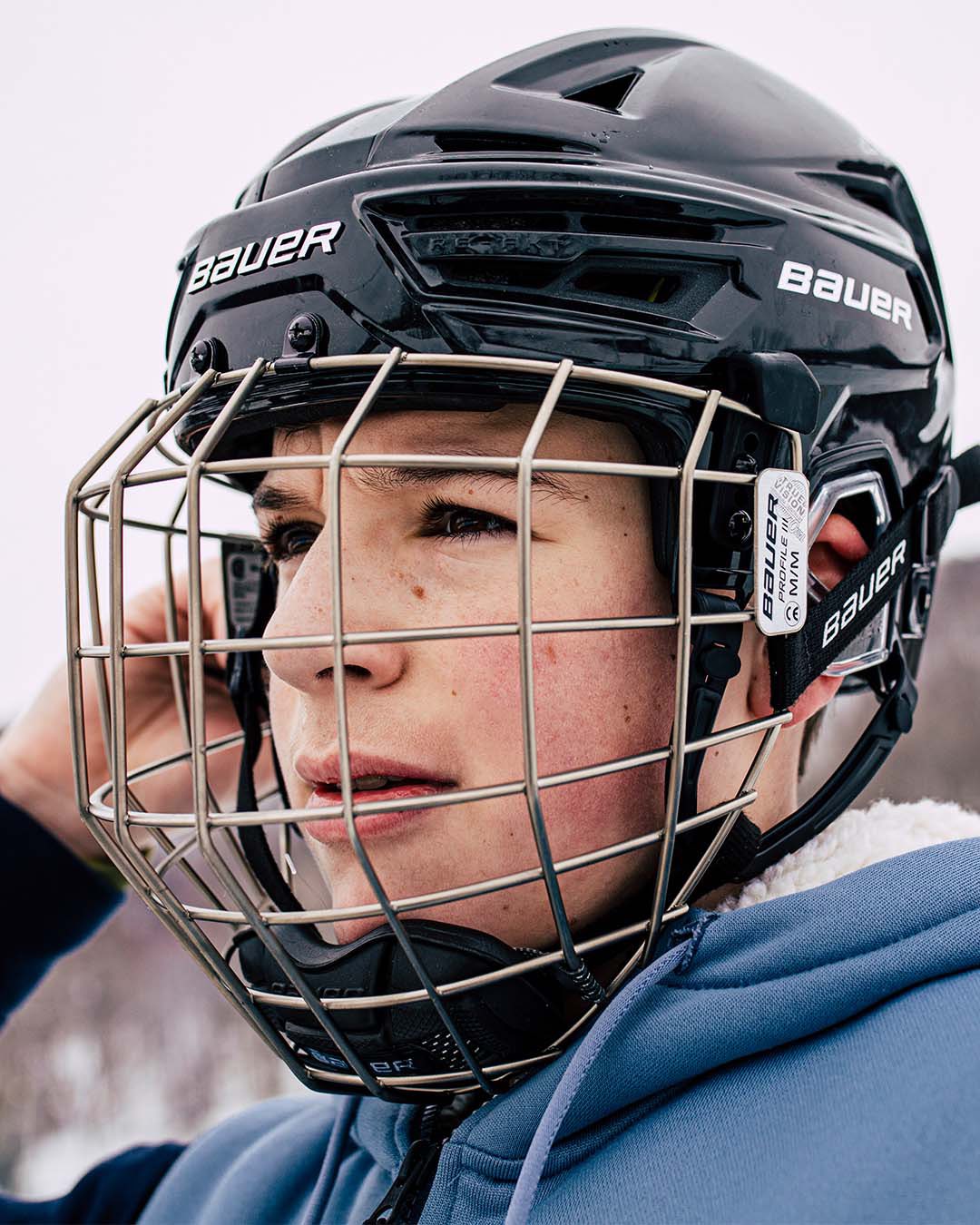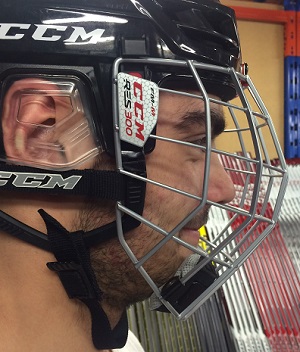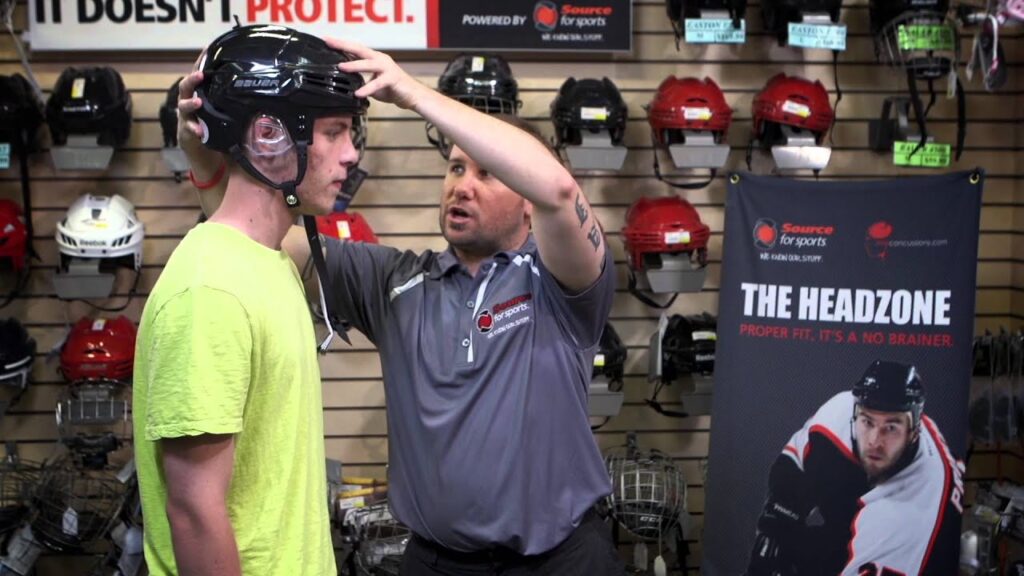A hockey helmet should fit snugly, covering the entire head without any gaps. It should sit one finger width above the eyebrows.
Proper helmet fit is crucial for safety. A well-fitted helmet protects against head injuries during play. It should feel comfortable but tight enough to stay in place during movement. Adjustable straps and a chin cup ensure a secure fit. Regularly check the helmet for any damage or wear.
A good fit also enhances confidence on the ice. Always follow manufacturer guidelines for fitting. Investing time in finding the right fit can prevent serious injuries. Prioritize comfort and safety for the best hockey experience.

Credit: twitter.com
Importance Of A Proper Fit
A hockey helmet is a crucial piece of equipment for every player. The importance of a proper fit cannot be overstated. A well-fitted helmet ensures safety and boosts performance. Here’s why a properly fitting helmet matters.
Safety Benefits
Safety is the top priority for any hockey player. A helmet that fits properly reduces the risk of head injuries. Here are the key safety benefits:
- Impact Protection: Proper fit distributes impact evenly across the head.
- Concussion Prevention: Reduces the likelihood of concussions.
- Face Protection: Ensures the face shield stays in place.
Without a proper fit, a helmet can shift during play. This exposes the player to serious injuries. Make sure your helmet fits snugly and securely.
Performance Enhancement
A well-fitted helmet also improves your performance on the ice. Here’s how:
| Aspect | Benefit |
|---|---|
| Comfort | Reduces distractions, allowing better focus on the game. |
| Vision | Ensures the visor or cage doesn’t obstruct your view. |
| Stability | Prevents the helmet from moving during intense plays. |
Comfort plays a big role in how well you perform. A helmet that fits well feels like a part of your body. This allows you to play more naturally and confidently.
Measuring Your Head
Measuring your head is the first step in finding the perfect hockey helmet. A well-fitting helmet is crucial for safety and comfort on the ice. Follow these steps to ensure you get the right fit.
Finding The Right Size
To find the right size, measure the circumference of your head. Use a soft measuring tape for the most accurate result. Place the tape about an inch above your eyebrows, around the largest part of your head.
| Head Circumference | Helmet Size |
|---|---|
| 20″ – 21.5″ | Small |
| 21.5″ – 23″ | Medium |
| 23″ – 24.5″ | Large |
Tools You Need
You will need a few tools to measure your head accurately. These include:
- A soft measuring tape
- A mirror (optional but helpful)
- A notepad and pen to jot down measurements
Ensure the measuring tape is snug but not tight. Repeat the measurement a few times for accuracy. Write down the largest measurement.
Helmet Types
Choosing the right hockey helmet is crucial for safety and comfort. The two main types of helmets are youth helmets and adult helmets. Each type has specific features to cater to different age groups and head sizes.
Youth Helmets
Youth helmets are designed for children and young teens. They are lighter and smaller, ensuring a snug fit for smaller heads. Proper fitting is essential to provide maximum protection and comfort.
- Measure the head circumference before purchasing.
- Ensure the helmet sits one inch above the eyebrows.
- Check that the chin strap is secure but not too tight.
Here is a table summarizing the key features of youth helmets:
| Feature | Description |
|---|---|
| Lightweight | Easy for kids to wear for long periods. |
| Adjustable | Allows for growth and ensures a snug fit. |
| Extra Padding | Provides added comfort and protection. |
Adult Helmets
Adult helmets are built for teenagers and adults. They offer more advanced features for improved safety and performance. Proper fit is crucial for optimal protection.
- Measure head circumference accurately.
- Ensure the helmet covers the entire skull.
- Verify that the chin strap is tight but comfortable.
Here is a table summarizing the key features of adult helmets:
| Feature | Description |
|---|---|
| Advanced Protection | Incorporates advanced materials for better safety. |
| Custom Fit | Often includes adjustable components for a perfect fit. |
| Durable | Made to withstand more intense impacts. |
Adjusting The Helmet
Properly adjusting a hockey helmet ensures safety and comfort during the game. A good fit reduces the risk of injuries and enhances performance. Let’s explore how to adjust the helmet for the perfect fit.
Strap Adjustments
The straps play a crucial role in keeping the helmet secure. Follow these steps to adjust the straps properly:
- Place the helmet on your head. Make sure it sits level.
- Adjust the chin strap. It should be tight but comfortable.
- Check the ear straps. They should form a “Y” around your ears.
- Buckle the chin strap. Ensure it is snug under your chin.
Important: The helmet should not move when you shake your head.
Padding Adjustments
Padding inside the helmet affects the fit and comfort. Adjust the padding as follows:
- Remove or add padding for a snug fit.
- Ensure the padding covers your forehead and temples.
- Check the padding regularly. Replace it if worn out.
- A well-padded helmet should feel snug but not tight.
Tip: Test the fit by shaking your head. The helmet should stay in place.
| Adjustment Type | Steps |
|---|---|
| Strap Adjustment |
|
| Padding Adjustment |
|
Remember, a well-adjusted helmet is essential for safety on the ice. Proper strap and padding adjustments make the helmet fit securely and comfortably.
Testing The Fit
Ensuring your hockey helmet fits properly is crucial for safety. A well-fitted helmet protects your head during intense plays. Here are the steps to test if your helmet fits perfectly.
Shake Test
First, wear your hockey helmet and fasten the chin strap. Now, shake your head vigorously from side to side. Your helmet should stay in place. If the helmet shifts or moves, it’s too loose. Tighten the straps or adjust the size.
Next, nod your head up and down. The helmet must remain stable. A helmet that moves up and down needs adjusting. It should fit snugly around your head.
Comfort Check
After the shake test, wear the helmet for about 10 minutes. This helps you determine if it’s comfortable for longer periods. The helmet should not cause pressure points or pain.
Check the padding inside the helmet. It should feel soft but firm. The padding should touch your head evenly all around. If there are gaps, the helmet might be too big.
Lastly, ensure the chin strap is comfortable. It should sit snugly under your chin without digging into your skin. You should be able to fit one finger between the strap and your chin.
Common Fit Issues
A hockey helmet should fit correctly to ensure safety and comfort. Many players face common fit issues that can affect performance and protection. Understanding these issues can help in achieving the perfect fit.
Too Tight
A helmet that is too tight can cause discomfort and headaches. Here are some signs your helmet might be too tight:
- Pressure points on the forehead.
- Red marks or indentations on the skin.
- Difficulty putting the helmet on or taking it off.
A tight helmet restricts movement and can lead to dizziness. To adjust, loosen the straps or opt for a larger size. Ensure it sits snugly without squeezing.
Too Loose
A helmet that is too loose offers poor protection. Signs of a loose helmet include:
- Helmet shifts during movement.
- Straps dangle loosely without securing.
- Gaps between the helmet and your head.
A loose helmet can fall off during play, increasing injury risk. Tighten the straps and ensure a snug fit. The helmet should stay in place when you shake your head.
Maintenance Tips
Proper maintenance of a hockey helmet ensures safety and longevity. Regular care helps keep the helmet in top condition.
Cleaning The Helmet
Clean the helmet after each game or practice. Use a soft cloth and mild soap. Avoid harsh chemicals that can damage the helmet.
- Remove the padding: Take out the inner padding for separate cleaning.
- Wash the shell: Gently scrub the outer shell with soapy water.
- Rinse and dry: Rinse with water and let it air dry.
Replacing Parts
Check the helmet regularly for wear and tear. Replace damaged parts immediately.
- Inspect the straps: Ensure the chin strap is secure and not frayed.
- Check the padding: Replace worn or compressed padding.
- Examine the shell: Look for cracks or dents and replace if needed.
Regular maintenance guarantees your helmet provides the best protection.

Credit: www.youtube.com
When To Replace Your Helmet
Knowing when to replace your hockey helmet is crucial for safety. A helmet in poor condition won’t protect you properly. Check for certain signs to know when it’s time for a new one.
Signs Of Wear
Look for cracks or dents on the helmet’s shell. These are clear signs of damage. The padding inside should be firm and intact. Soft or missing padding means less protection.
Check the straps and buckles. They should be strong and secure. Weak or broken straps can lead to a loose helmet. Examine the fit. If the helmet feels loose or wobbly, it might be time for a new one.
Post-impact Replacement
After a hard fall or hit, inspect your helmet. Even without visible damage, it might be compromised. Helmets are designed to absorb one major impact. After that, their effectiveness is reduced.
Look for any signs of compression or deformation. These indicate the helmet has absorbed a significant impact. If you notice any, replace the helmet immediately. Safety should never be compromised.
| Signs of Wear | What to Check |
|---|---|
| Cracks or Dents | Inspect the helmet’s shell for any visible damage. |
| Padding | Ensure the padding is firm and intact. |
| Straps and Buckles | Check for strength and security. |
| Fit | Make sure the helmet is not loose or wobbly. |
- Replace your helmet if you see any cracks or dents.
- Check the padding for firmness and presence.
- Inspect straps and buckles for strength.
- Ensure the helmet fits snugly and securely.
- Inspect your helmet after every fall or hit.
- Look for signs of compression or deformation.
- Replace the helmet immediately if any signs are found.

Credit: howtohockey.com
Conclusion
A properly fitting hockey helmet is essential for safety and performance. Ensure it’s snug but comfortable, with no pressure points. Regularly check the fit as your head shape might change over time. Prioritize your safety by investing time in selecting the right helmet.
Your head will thank you!


